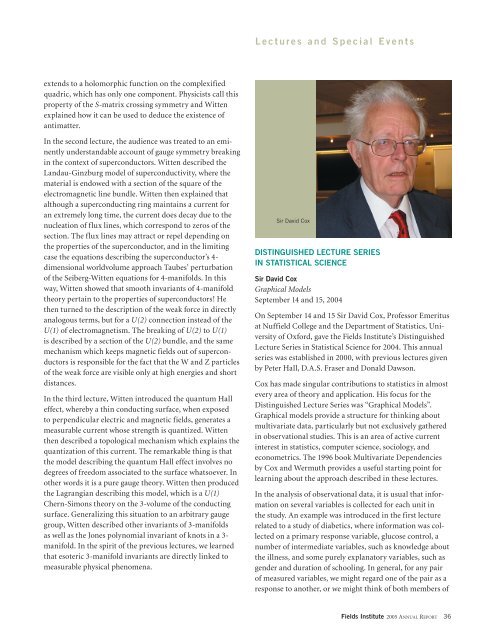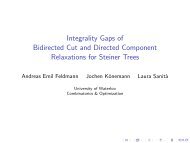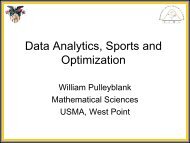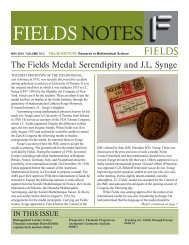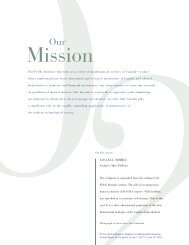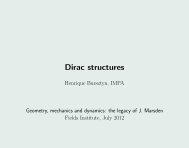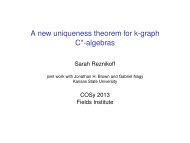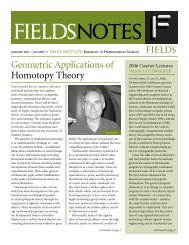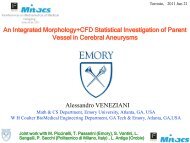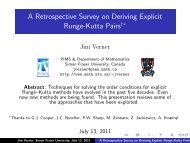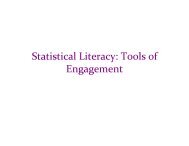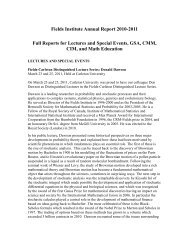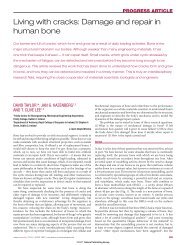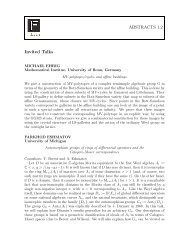Annual Report 2005 - Fields Institute - University of Toronto
Annual Report 2005 - Fields Institute - University of Toronto
Annual Report 2005 - Fields Institute - University of Toronto
Create successful ePaper yourself
Turn your PDF publications into a flip-book with our unique Google optimized e-Paper software.
extends to a holomorphic function on the complexified<br />
quadric, which has only one component. Physicists call this<br />
property <strong>of</strong> the S-matrix crossing symmetry and Witten<br />
explained how it can be used to deduce the existence <strong>of</strong><br />
antimatter.<br />
In the second lecture, the audience was treated to an eminently<br />
understandable account <strong>of</strong> gauge symmetry breaking<br />
in the context <strong>of</strong> superconductors. Witten described the<br />
Landau-Ginzburg model <strong>of</strong> superconductivity, where the<br />
material is endowed with a section <strong>of</strong> the square <strong>of</strong> the<br />
electromagnetic line bundle. Witten then explained that<br />
although a superconducting ring maintains a current for<br />
an extremely long time, the current does decay due to the<br />
nucleation <strong>of</strong> flux lines, which correspond to zeros <strong>of</strong> the<br />
section. The flux lines may attract or repel depending on<br />
the properties <strong>of</strong> the superconductor, and in the limiting<br />
case the equations describing the superconductor’s 4dimensional<br />
worldvolume approach Taubes’ perturbation<br />
<strong>of</strong> the Seiberg-Witten equations for 4-manifolds. In this<br />
way, Witten showed that smooth invariants <strong>of</strong> 4-manifold<br />
theory pertain to the properties <strong>of</strong> superconductors! He<br />
then turned to the description <strong>of</strong> the weak force in directly<br />
analogous terms, but for a U(2) connection instead <strong>of</strong> the<br />
U(1) <strong>of</strong> electromagnetism. The breaking <strong>of</strong> U(2) to U(1)<br />
is described by a section <strong>of</strong> the U(2) bundle, and the same<br />
mechanism which keeps magnetic fields out <strong>of</strong> superconductors<br />
is responsible for the fact that the W and Z particles<br />
<strong>of</strong> the weak force are visible only at high energies and short<br />
distances.<br />
In the third lecture, Witten introduced the quantum Hall<br />
effect, whereby a thin conducting surface, when exposed<br />
to perpendicular electric and magnetic fields, generates a<br />
measurable current whose strength is quantized. Witten<br />
then described a topological mechanism which explains the<br />
quantization <strong>of</strong> this current. The remarkable thing is that<br />
the model describing the quantum Hall effect involves no<br />
degrees <strong>of</strong> freedom associated to the surface whatsoever. In<br />
other words it is a pure gauge theory. Witten then produced<br />
the Lagrangian describing this model, which is a U(1)<br />
Chern-Simons theory on the 3-volume <strong>of</strong> the conducting<br />
surface. Generalizing this situation to an arbitrary gauge<br />
group, Witten described other invariants <strong>of</strong> 3-manifolds<br />
as well as the Jones polynomial invariant <strong>of</strong> knots in a 3manifold.<br />
In the spirit <strong>of</strong> the previous lectures, we learned<br />
that esoteric 3-manifold invariants are directly linked to<br />
measurable physical phenomena.<br />
L e c t u r e s a n d S p e c i a l E v e n t s<br />
Sir David Cox<br />
DISTINGUISHED LECTURE SERIES<br />
IN STATISTICAL SCIENCE<br />
Sir David Cox<br />
Graphical Models<br />
September 14 and 15, 2004<br />
On September 14 and 15 Sir David Cox, Pr<strong>of</strong>essor Emeritus<br />
at Nuffield College and the Department <strong>of</strong> Statistics, <strong>University</strong><br />
<strong>of</strong> Oxford, gave the <strong>Fields</strong> <strong>Institute</strong>’s Distinguished<br />
Lecture Series in Statistical Science for 2004. This annual<br />
series was established in 2000, with previous lectures given<br />
by Peter Hall, D.A.S. Fraser and Donald Dawson.<br />
Cox has made singular contributions to statistics in almost<br />
every area <strong>of</strong> theory and application. His focus for the<br />
Distinguished Lecture Series was “Graphical Models”.<br />
Graphical models provide a structure for thinking about<br />
multivariate data, particularly but not exclusively gathered<br />
in observational studies. This is an area <strong>of</strong> active current<br />
interest in statistics, computer science, sociology, and<br />
econometrics. The 1996 book Multivariate Dependencies<br />
by Cox and Wermuth provides a useful starting point for<br />
learning about the approach described in these lectures.<br />
In the analysis <strong>of</strong> observational data, it is usual that information<br />
on several variables is collected for each unit in<br />
the study. An example was introduced in the first lecture<br />
related to a study <strong>of</strong> diabetics, where information was collected<br />
on a primary response variable, glucose control, a<br />
number <strong>of</strong> intermediate variables, such as knowledge about<br />
the illness, and some purely explanatory variables, such as<br />
gender and duration <strong>of</strong> schooling. In general, for any pair<br />
<strong>of</strong> measured variables, we might regard one <strong>of</strong> the pair as a<br />
response to another, or we might think <strong>of</strong> both members <strong>of</strong><br />
<strong>Fields</strong> <strong>Institute</strong> <strong>2005</strong> ANNUAL REPORT 36


